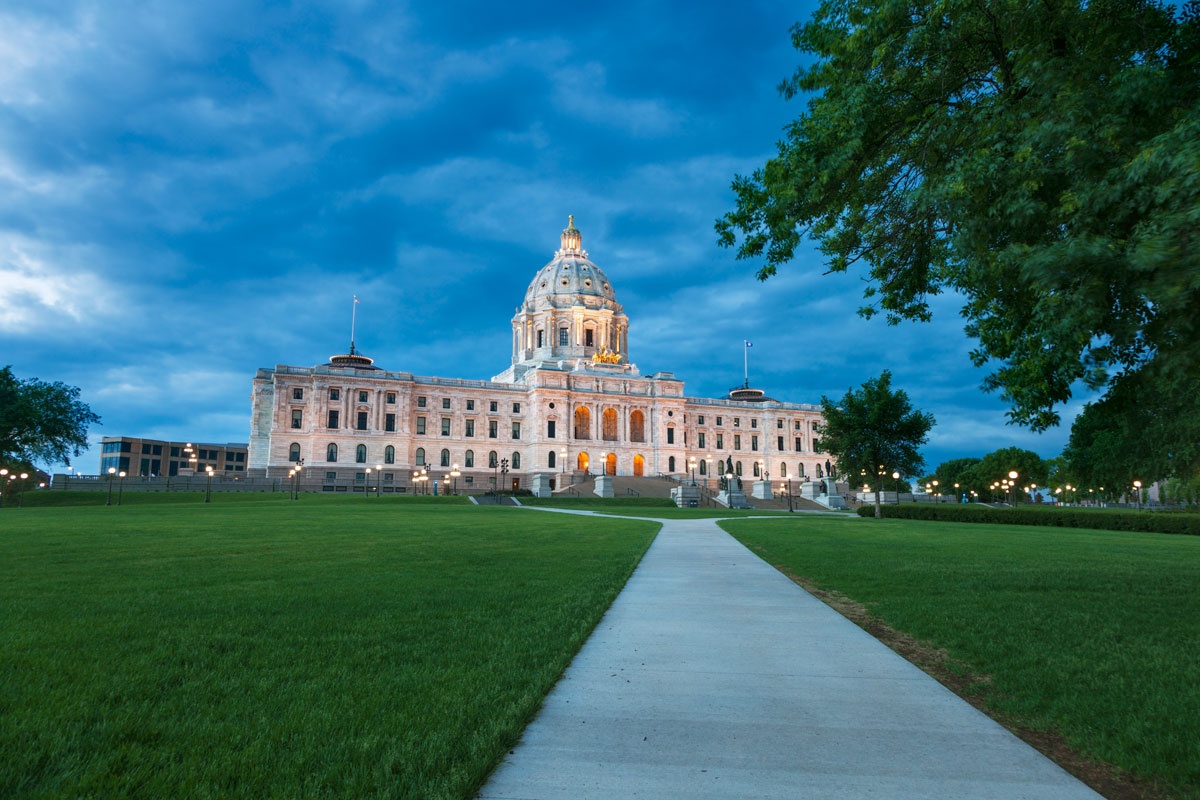The 2024 session was a success for Conservation Minnesota and our Great Outdoors. While our work began far before the beginning of session in January, success or failure came down to the final weekend before adjournment.
We’re happy to share that with the passage of the Packaging Waste & Cost Reduction Act, Minnesota now has one of the strongest extended producer responsibility (EPR) laws in the country and is the 5th state in the nation to enact this type of legislation. This was a hard-fought and important win. The bill survived 15 committee stops and floor votes, as well as dozens of industry lobbyists hired to kill or weaken it. A strong partnership between Conservation Minnesota and several Minnesota counties and two strong bill champions, Senator Morrison and Representative Jordan, were instrumental in getting the bill across the finish line. We thank all our members who contacted legislators about the issue.
After the 100% Clean Energy by 2040 bill was signed last session, we realized more policy changes would be necessary to achieve the new standards. The Public Utilities Commission convened a work group to formalize policy recommendations to expedite the clean energy build out. The Clean Energy Infrastructure Permitting Act passed this session will cut months or years off clean energy permitting timelines while ensuring transparency and robust public comment.
The Packaging Act & the Clean Energy Infrastructure Permitting Act are just two wins in a busy session. Below is a summary of more of our legislative accomplishments.
2024 Legislative Accomplishments
Great Outdoors, Habitats, & Wildlife
Great Outdoors Funding
Annual funding bills for the Clean Water, Land, & Legacy Amendment and Environment & Natural Resource Trust funds passed with bipartisan support.
Elk Policy
Last session, Conservation Minnesota partnered with the Fond du Lac Band of Lake Superior Chippewa to pass a bill and dedicate funding to reintroduce wild elk in northeast Minnesota. This year’s new policy will allow the Department of Natural Resources (DNR) to grow the northwest elk herd in preparation for relocating some elk to northeast Minnesota.
Trees!
The Environment Omnibus dedicated about $12 million just to tree planting this session. The spending will be split between community tree planting grants in environmental justice communities, state parks, metro parks, state forests, and other public lands.
Reducing Waste & Eliminating Toxic Chemicals
The Packaging Waste & Cost Reduction Act
The Packaging Act will require all packaging in Minnesota be reuseable, recyclable, or compostable by 2032. Significant funding will come from the brands selling the packaging to improve municipal reuse, recycling, and composting opportunities. Some municipalities may reduce or eliminate the recycling fees paid by customers.
Additional policies will improve recycling opportunities in schools and public spaces, and new attention will begin to address toxic chemicals in packaging. In just a few years, the reuse, recycling, and composting landscape will begin to look noticeably different.
Boat Wrap Disposal
Starting in 2025, plastic boat wrap producers will be required to develop a stewardship plan, join a producer responsibility organization, educate the public about the plan, and collect and recycle the plastic film used to cover boats in the winter.
Natural Gas from Food & Yard Waste
Funding was secured to build an anaerobic digester facility in Shakopee. The digester will take thousands of pounds of food and yard waste and produce renewable natural gas, which will be incorporated into the Centerpoint system.
Critical Materials Task Force Created
Minnesotans throw away thousands of pounds of rare minerals and materials that are in demand for use in consumer electronics and renewable energy. This task force will investigate the problem and recommend solutions for infrastructure, labor, and policy to recover more of these in-demand materials and reuse and recycle them instead of burning or burying them. Conservation Minnesota partnered with the members of the BlueGreen Alliance to support this new task force.
Clean Water
Agricultural Runoff & Public Waters
Minnesota’s “public waters” are wetlands, streams, lakes, and other waterways in which the DNR holds regulatory jurisdiction. The decades-old DNR map of these public waters, called the Public Water Inventory (PWI), may not include some waterways that should be considered public waters.
The Public Waters Inventory Mapping & Definition Bill should help solve this issue by 2032. With the new mapping, more lakes and streams will likely qualify for buffer strips—natural stretches of vegetation that help slow fertilizer runoff. The Environmental Protection Agency (EPA) has ordered Minnesota to be more aggressive in addressing the nitrate pollution problem in the southern part of the state.
Clean Energy & Mining
Clean Energy Infrastructure Permitting Act
These permitting policies will cut months or years off clean energy permitting timelines while ensuring robust public comment and the transparency of the permitting process remain unchanged. The new policies move environmental review staff between the Department of Commerce and the PUC next year, reduce overlapping and inefficient permitting guidelines, and speed up Minnesota’s decarbonization of the electric sector.
Helium Permitting
A recently discovered helium deposit in Lake County has drawn attention from the DNR and legislators, and shed light on the lack of regulation Minnesota has for extracting gaseous compounds. Minnesota mining laws have been on the books for centuries and require that if a private actor benefits from extracting a public resource, that actor must pay taxes to benefit the surrounding communities and the state. No such state law existed for the extraction of helium gas, until this session. Helium and other gases extracted from public lands will now be subject to similar regulatory and financial commitments as other forms of extraction.
Coordinated Project Plans
Business interests have long complained that Minnesota’s regulatory framework makes permitting take too long and makes Minnesota less competitive in attracting business investments. Whether or not that is true is subject to debate, but a proposal to help agencies coordinate their work on proposed permits was passed in the Environment Finance Omnibus this session. This proposal just formalized what the DNR and Minnesota Pollution Control Agency (MPCA) were already doing to coordinate with potential permittees on projects in the state.
Additional bills
- Grid enhancement and interconnection improved
- Geothermal rules updated and funding dedicated
- Food waste hierarchy and composting grants
- Ban on mercury-containing lighting
- Resilient community assistance program
- State park license plate redesign contest
- Monitoring for PFAS in biosludge

